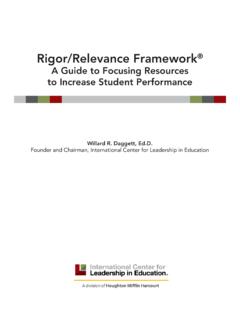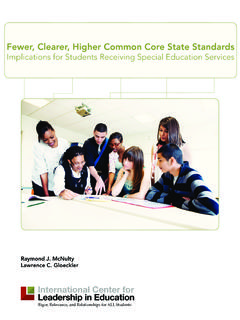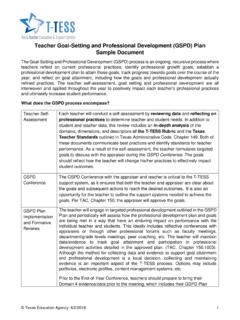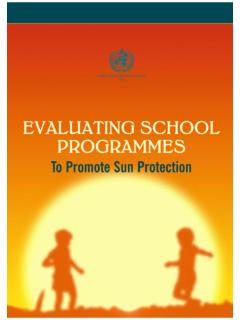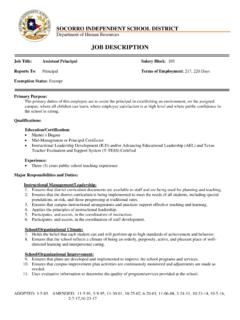Transcription of Addressing Current and Future Challenges in …
1 LESSONS LEARNED FROM THE NATION S MOST RAPIDLY IMPROVING AND TRANSFORMATIVE SCHOOLSBill Daggett, AND CHAIRMANINTERNATIONAL CENTER FOR LEADERSHIP IN EDUCATIONJune 2014 Addressing Current and Future Challenges in Education22nd AnnualModel Schools ConferenceMAKING CHANGE IN SCHOOLS IS ESSENTIAL, BUT IS ALSO FRAUGHT WITH Challenges . Any ambitious new initiative is bound to have supporters, detractors, and obstacles to a seamless rollout. We see this scenario playing out in schools as they introduce new academic standards (the Common Core State Standards [CCSS], the Texas Essential Knowledge and Skills [TEKS], and the Virginia Standards of Learning [SOL]), assessments, and teacher evaluation programs.
2 Last year, two states New York and Kentucky moved to a new testing program tied directly to CCSS, and encountered significant implementation Challenges . Both states experiences should serve as an early warning signal to other states, and an indicator that we need to introduce change the aftermath of the 1983 A Nation at Risk report to the No Child Left Behind Act of 2001, to the CCSS, TEKS, and SOL, new initiatives in education have always been accompanied by strong reactions and emotionally packed debate. However, the need for continuous improvement and shifts in instructional practices is clear. If we cut through the distractions, most people agree on the urgency and the intent of these Current initiatives: to prepare students to be successful in the rapidly evolving global economy.
3 To achieve this vision, we must find a way to create an academically rigorous and relevant educational experience for all of our K 12 students. The CCSS, TEKS, and SOL initiatives are the latest in a series of valiant attempts over the past 30 years to do just that. While our schools continue to provide a quality education to our students, the world in which students will live and work is changing and advancing at an even faster rate than improvements in our schools. In spite of our best efforts, many schools are not preparing students for success in the world they will inhabit after , out of the array of school improvement initiatives that have been introduced over the last three decades, a number of schools have found ways to keep pace with the rate of change in society.
4 Their students are prepared for a world that demands higher and arguably, different levels of knowledge and skills than ever the International Center for Leadership in Education, we continue to find, analyze, and showcase the nation s most rapidly improving schools. We have studied how these schools have succeeded in improving student performance. I believe our findings can provide all schools and their leaders with direction in meeting the significant Challenges they now | Addressing Current and Future Challenges in Education Five central tenets outline what these effective and rapidly improving schools and districts do differently from their counterparts across the nation: Address today s challenging issues within the context of emerging trends.
5 While dealing with the wide array of issues that challenge school leaders daily, exemplary leaders keep a careful eye on emerging and disruptively transformative trends that may impact their schools, teachers, and students in the next one to three years. By doing so, they avoid making short-term decisions that will haunt them in the near Future as the disruptive trends change the dynamics in and around schools. Culture trumps strategy. Successful schools create a culture that supports improvement before they attempt to implement change. Without a strong cultural foundation, the proposed solution can be mistaken for the problem. This was the misstep that occurred with the introduction of CCSS and new teacher evaluation systems in New York and Kentucky.
6 Take control or be controlled. School leaders do not allow themselves to be distracted by external pressures. Within the framework of their system-wide strategic approach, these leaders put in place short-term typically 20-day action plans for administrators and teachers. These action plans have specific, measurable outcomes related to the improvement of student performance. School staff act upon, monitor, and revise these plans continually to inform the next short-term action plan cycles. It takes a system to improve student performance. Actions at the organizational leadership, instructional leadership, and teaching levels are coordinated and aligned to support instruction and learning.
7 Improving student performance to agreed-upon levels is non-negotiable in every classroom. What varies is how the schools achieve that improved performance. Use data to make decisions. High-performance schools and districts use data to define expectations, to constantly monitor progress, and to diagnose the effectiveness of instructional practices in real time. Using such information, they adjust course immediately based upon the data. While each of these five tenets is powerful on its own, they are strongly connected, and the most effective schools build their transformative work around all five. In the following pages, we will explore the big ideas and details behind each key concept, and discuss how these tenets look when put into practice across schools and 2014 | 3 12345 TENET 1: ADDRESS TODAY SCHALLENGING ISSUES WITHIN THE CONTEXT OFEMERGING TRENDST oday s school and district leaders face a host of issues many of them controversial that demand immediate and ongoing attention.
8 Among the most significant are: Transitioning to higher standards Aligning new assessments to the new standards Implementing teacher evaluation systems Managing budgets and spending with unprecedented restrictions The challenge of implementing higher standards, new assessments, and teacher evaluation systems deprives school leaders of time to do much else, such as preparing for disruptive and transformative emerging trends that will impact students and staff for decades to the nation s most rapidly improving schools, we have found leaders who are dealing with today s challenging issues within the context of potentially disruptive, emerging trends.
9 In the process, they have avoided making short-term decisions that will haunt them in the near Future as the disruptive, emerging trends change the dynamics in and around our should consider five disruptive emerging trends as they make decisions to address today s issues:1. IMPACT OF DIGITAL LEARNING 2. HEIGHTENED DEMAND FOR CAREER READINESS3. INCREASED EMPHASIS ON APPLICATION-BASED LEARNING4. USE OF DATA ANALYTICS TO IMPLEMENT GROWTH MODELS5. DEVELOPING PERSONAL SKILLSL eaders need to understand and manage the potential impact of these trends rather than wait until the trends gain momentum and then try to respond. EMERGING TREND #1: Impact of Digital Learning Digital learning is a catalyst for college and career readiness.
10 Today s learners are digital natives yet they come to school and power down their devices. As educators, we need to embrace the power of technology to make learning relevant for all students and adults. Using technology effectively in everyday learning can help students to strengthen their learning experiences and build on their intuitive technology skills. Using technology thoughtfully for instructional purposes will allow us to stretch learners thinking in ways that will lead to success in today s increasingly global economy and rapidly evolving digital environment. Blended learning and microcredentialing are key areas to , Horn and Staker describe a blended-learning taxonomy, the Station Rotation, Lab Rotation, and Flipped Classroom models as methods to blend the main features of both the traditional classroom and online learningi.


